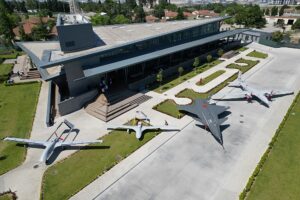Next up in our “Ask Drone Girl” series is a question about how to track drones flying near you. If you have a question for Drone Girl, contact her here.
I am in Massachusetts and have been watching the skies for about a month and have been totally fascinated by the various types of drones I have seen. I live close to the Norwood Airport, which says they allow drone operation. Is there an app or website that allows me to see what kinds of drones and who is manning them in my area, specifically over my house most nights?
Your story captures something many people experience when they notice drones buzzing overhead: initial curiosity, a twinge of unease, and then full-on fascination. Especially as media built up hype around New Jersey drone sightings, people grew increasingly curious (and built up conspiracy theories) around what’s in the skies.
Living near Norwood Airport, you’re in a hotspot for aerial activity of all kinds, so it makes sense that you’d want to know how to track drones flying near you.
The short answer: there is currently no great way to track drone flights in the U.S. With out, there’s no great way to know who is flying them and what those drone flights are for. Sure, later on I’ll dive into the tools and technologies available that can get you closer to the answer. But before we do, I want to give you an overview of the airspace today, and where it’s headed:
Everything you need to know about drone spotting
ADS-B (and why drones don’t use it)
If you want to know what manned aircraft is flying over head, it’s incredibly easy to do so, and that’s thanks to technology called ADS-B.
Short for Automatic Dependent Surveillance–Broadcast, this is a technology used by airplanes to share their location, altitude, speed and identification in real-time. Airplanes equipped with ADS-B continuously broadcast this data to ground-based receivers and nearby aircraft. This system enhances air traffic safety by ensuring that pilots, air traffic controllers, and even the general public. Free apps like FlightRadar24 make this easy.
So why don’t drones simply use ADS-B to make them equally traceable? Here are a few reasons why:
Frequency congestion
The skies are already crowded with ADS-B signals from manned aircraft. If millions of drones started using the same frequencies, it could overload the system, causing delays or interruptions in critical aviation data.
Different needs for drones vs. planes
Planes travel at high speeds across vast distances, making ADS-B critical for collision avoidance and route planning. Drones, on the other hand, often operate at much lower altitudes, slower speeds and in smaller areas, so a more specialized system like Remote ID (more on that later) makes sense for tracking.
Weight and power constraints
ADS-B transponders are relatively large and consume significant power. Many drones, especially smaller ones like the DJI Mini 4 Pro, are built to be lightweight and compact. Thus, adding an ADS-B transponder would be impractical.
That said, some larger drones used for professional or military purposes are equipped with ADS-B to increase situational awareness in shared airspace, especially if they’re flying near manned aircraft.
Remote ID
Only in 2024 did the Federal Aviation Administration (FAA) begin enforcing compliance with what’s called Remote ID. Remote ID is a system something like a digital license plate for drones, where technology inside the drone can broadcast that drone’s location and operator information to nearby receivers.
Under the FAA’s Remote Id rules, drones that weigh 250 grams or more must be remote id-compliant. That means they either:
- Have a built-in Remote ID capability: Most new drones sold from major manufacturers have this already.
- Use a separate Remote ID module: Other drones that don’t already come with this built in, such as older or home-built drones, likely need a separate Remote ID module.
- Are flying at a FRIA: Short for FAA-Recognized Identification Areas, FRIAs are spots where drones without Remote ID broadcast capabilities can operate legally, typically lparks owned by FAA-recognized community based organizations. This includes many model airplane fields or educational institutions. Use the FAA’s UAS Data Delivery Service (UDDS) website to find a FRIA near you.
But as far as the data actually being collected through Remote ID? Right now, that information isn’t available in a public website like FlightRadar24. Rather, the FAA only uses Remote ID to identify drones in situations where the drone is flying unsafely or in a restricted area.
UTM: the future of drone tracking
There are efforts to be able to track drones flying in the U.S. in the future. That’s through the FAA’s Unmanned Traffic Management (UTM) system. This is a massive, long-term project intended to make drone operations more akin to traditional air traffic, with UTM being that air traffic control system for drones. With it, you could track, rout and communicate between drones, operators and regulators.
Here’s what UTM might mean for curious observers like you:
Public awareness:
UTM could include publicly accessible features, enabling people like you to identify drones flying overhead. While it’s not yet clear how much information will be shared with the general public, the system is being designed with transparency in mind.
Real-time drone tracking:
UTM will build upon current Remote ID implementation. This would allow authorities (and possibly the public) to see not just the drone’s location but also its flight plan, purpose and operator information in real time.
Collision avoidance and safety:
With UTM, drones will be able to “talk” to each other and other airspace users to avoid collisions. This system will be especially important as more drones are used for use cases like package delivery. With drone delivery, multiple drones fly in high-density areas.
How close are we to UTM and being able to track drones?
Don’t expect to be able to track drones anytime soon — and definitely not this year. We’re still in the early stages, though here’s some background on where progress is being made:
- NASA and the FAA, in partnership: Over the past few years, NASA and the FAA have conducted UTM trials. They’re testing everything from small delivery drones to larger aircraft integration.
- Testbeds in action: UTM prototypes are already being tested in urban areas like Reno, Nevada, and Dallas, Texas. There, companies are testing use cases like package delivery.
- Integration with Remote ID: Remote ID is essentially UTM’s foundation. By mandating Remote ID compliance (only a recent effort), the FAA is preparing for a fully integrated UTM system.
Tracking drones: the bottom line
Crewed aircraft already have systems like ADS-B that make tracking straightforward. Meanwhile, drones currently operate in a more fragmented regulatory environment. That said, the combination of UTM, Remote ID and future technology enhancements indicate that we’re moving toward a world where drones are as traceable as airplanes — without overloading systems like ADS-B.
The post How can I track drones flying near me? appeared first on The Drone Girl.




